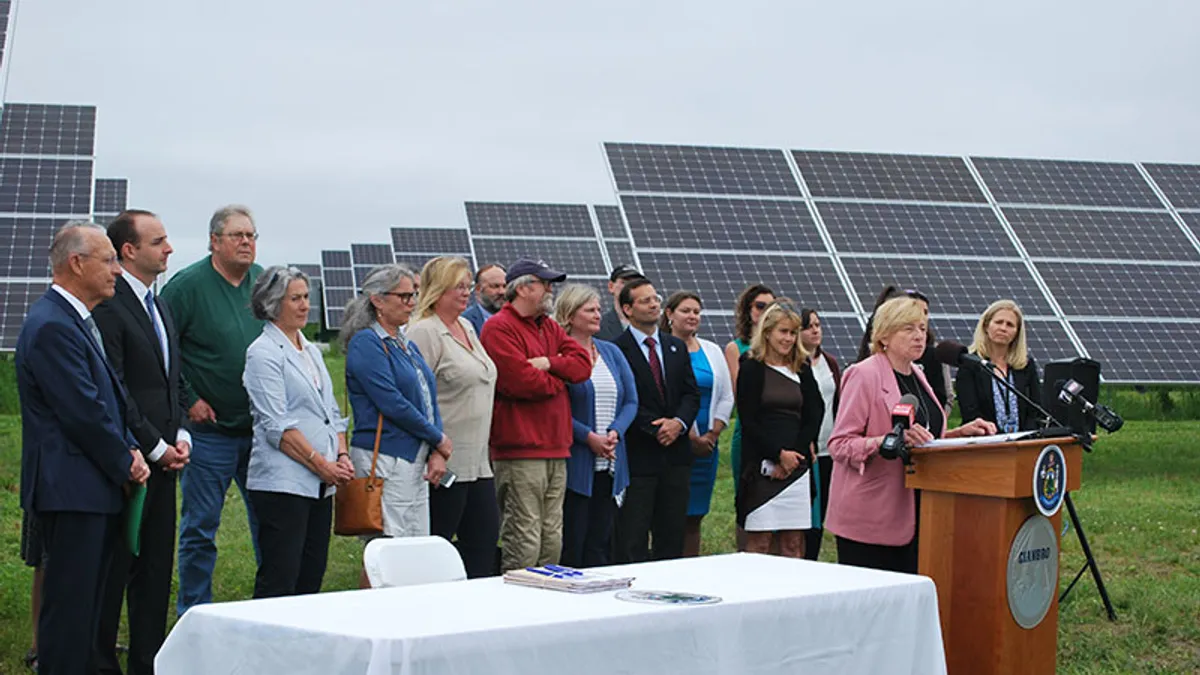Dive Brief:
- The Maine Public Utilities Commission approved on Tuesday the terms for 546 MW of renewable energy projects, of which 482.5 MW were new solar resources. The projects mark the largest renewable energy procurement in the state's history, representing about 10% of the state's load.
- 17 bidders were selected to enter into 20-year contracts with both or either of Maine's investor-owned utilities, Central Maine Power and Emera Maine. Prices ranged from $0.029 to $0.042/kWh, Commission Chairman Philip L. Bartlett II told the Portland Press Herald.
- The projects also include 20 MW of new wind, 39 MW of existing biomass and 4.5 MW of existing hydropower. The Request for Proposals, issued in February, accepted energy storage proposals but none of those projects were selected.
Dive Insight:
Gov. Janet Mills, D, and the state legislature worked in tandem last year to change the state's Renewable Portfolio Standard (RPS) into one of the most ambitious programs in the country.
The procurement is part of that effort, in response to LD 1494, which Mills signed into law last summer. The bill requires the PUC to direct the procurement of renewables that may be paired with energy storage.
Maine is on its way to reaching 90% renewable energy with the new slew of projects, after the state updated its RPS goal last year to reach 100% clean energy by 2050. Prior to the update, Maine was targeting 10% renewable energy by 2017, which it had already surpassed.
The Maine legislature directed the PUC to conduct two competitive solicitation processes to procure renewable energy resources or renewable energy credits for 14% of the 2018 retail electricity sales in the state. While the first tranche of projects met the majority of that requirement, a second procurement process, which must be initiated no later than Jan. 15, will need to acquire the rest.
"A lot of the kind of legislation that was passed last session related to climate and clean energy was done in a bipartisan manner," Dan Burgess, director of the Governor's Energy Office, said, as a "testament to the Governor's leadership on these issues" as well as the interest in stakeholders to build consensus on clean energy policy.
Only about 90 MW of the state's current non-hydroelectric renewable resources are solar, and the first tranche of the procurement seeks to change that, along with key changes to net metering the state made last year. The Governor's Energy Office is tracking "the resiliency and intermittency issues" related to the state's solar build-out, "as well as ensuring that our programs are cost-effective for Maine rate payers," Burgess said.
The largest project approved in the first tranche, from Three Rivers Solar Power, a subsidiary of Swift Current, will be 100 MW of solar.
Given the large infusion of intermittent renewable energy through this procurement, the state will be tracking grid resilience, according to Burgess. The Governor's Energy Office is mandated to complete an RPS study by the end of January 2021, which will look at several components including "the resiliency question and the right mix" for the state, according to Burgess.
Meanwhile, the Maine Climate Council will present its action plan by Dec. 1. to Gov. Mills and the state legislature. Its working group recommendations are currently being reviewed, and would establish different timelines for electrifying transportation, and increasing building efficiency and electrification.
Maine generates a small portion of its electricity from coal and petroleum — renewables, including hydropower, made up 80% of the state's net generation in 2019, and the state has the largest amount of wind energy in the Northeast, according to EIA. While only one of the 17 projects accepted in the first tranche of the procurement was wind related, the state is expanding its wind portfolio through other projects. The University of Maine announced in August a demonstration project to construct a floating offshore wind turbine, expected to be completed in 2023.















